« Sorry for the silence | Main | Colombian contractors in Iraq »
August 15, 2006
Notes from Putumayo
This was my third visit since 2001 to Putumayo, a small department in Colombia's far south, along the border with Ecuador. I've also taken two other trips very close to Putumayo, one to the Ecuadorian side of the international border, and one to a meeting of Putumayo community leaders just over the departmental border in eastern Nariño.
I keep coming back to Putumayo because there is no better place to gauge the impact, the success or failure, of U.S. policy in Colombia. This province of perhaps 350,000 people is where Plan Colombia basically got started, back in 2000-2001.
At that time, Putumayo had far more coca than any of Colombia's 32 departments, along with a very heavy FARC guerrilla presence, while its principal towns were being methodically, brutally taken over by paramilitaries. Putumayo was the focus of the military "Push to the South" that lay at the heart of the Clinton Administration's big 2000 aid package. Supported by U.S. funds, trainers and contractors, a new Colombian Army Counter-Narcotics Brigade, bristling with helicopters, would clear Putumayo's coca-growing zones of armed groups, while augmented counter-narcotics police would coordinate vastly increased herbicide fumigation. In their wake would come alternative-development programs to help Putumayo's farmers participate in the legal economy.
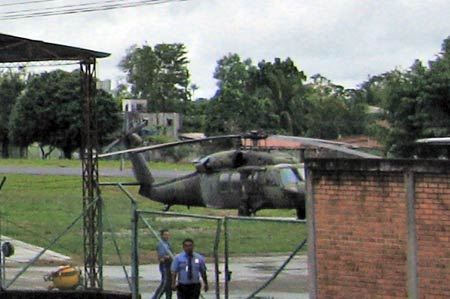 |
A U.S.-donated Colombian Anti-Narcotics Police Blackhawk parked at the Puerto Asís airport. |
Six years and untold hundreds of millions of dollars later, did the strategy work in Putumayo? No, mostly not, though there are a few bright spots.
Like much else in Colombia, the results in Putumayo tell us that the strategy needs to be very long-term, must consult closely with local leaders and organizations, and must go way, way beyond military operations and fumigation. And by all appearances, these lessons haven't come close to sinking in yet.
Here is a closer look, based on my all-too-brief visit.
The security situation appeared to be better, for now at least, though the last few years have shown that levels of security tend to oscillate wildly between relative safety and extreme danger. Right now, travel along main roads is possible, with the likelihood of running into guerrillas considered to be low. Road travel at night is still inadvisable, though doable.
We passed through more army and police checkpoints than I had seen before, and the security forces' presence was greater in general. Small contingents of soldiers were reliably stationed at key infrastructure points, including the rebuilt bridge over the Guamués River, which the FARC had blown up before my last visit in 2004, forcing us to board canoes to get across. Many of the soldiers and cops we saw were clearly from elite units, judging from their physical size and the quality of their equipment. (The soldiers who patted us down at checkpoints, however, were generally smaller and younger.)
Some small towns along the main road that had no police presence before, such as El Tigre or Buenos Aires, now had police stations. Also notable, especially in the oil-producing town of Orito, was the presence of troops from a new energy and road infrastructure-protection army brigade. Soldiers and police in many posts sat behind bags of cement piled high into walls, a bulletproof defense that resembled preparations for a flood.
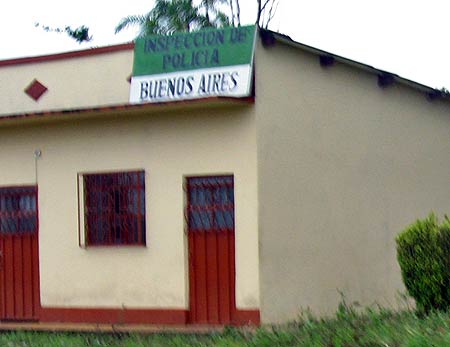 |
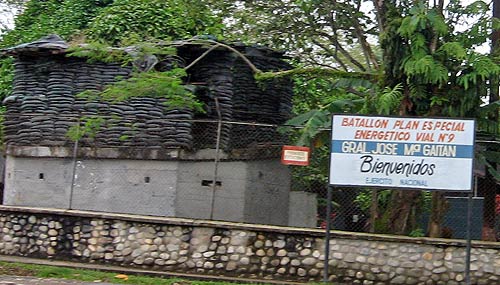 |
Though I've never run into uniformed guerrillas on any of my visits to Putumayo, one usually sees evidence of their activity. Guerrilla graffiti - once so common that it was even spray-painted on the sides of tractor-trailers that had passed through FARC roadblocks - was faded, when visible at all.
There was abundant evidence, though, of the last flare-up of guerrilla violence in the department, at the beginning of this year in the run-up to the March legislative elections. A guerrilla "armed stoppage" (paro armado) halted road traffic between towns for weeks, bringing shortages, while attacks on power lines left much of Putumayo in the dark. Along the main road were burned patches from trucks that the guerrillas set afire for disobeying the stoppage. As on previous visits, blackened trees and pools of sludge indicated places where the guerrillas had recently blown holes in the oil pipeline that follows the main road for much of its length.
 |
Faded guerrilla graffiti. |
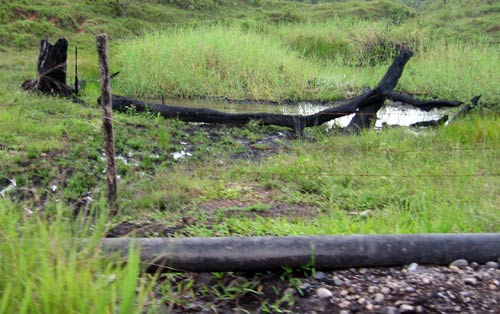 |
A common sight on the main road - a recently blown-up patch of pipeline with a pool of oil sludge. |
The increased military and police presence - in part a response to the wave of violence at the beginning of the year - had made conditions more secure in general. However, several local leaders indicated, flare-ups of guerrilla activity were still common and could happen at any time. One likely reason was that a U.S.-supported military offensive immediately to the north of Putumayo, a two-year-old effort known as "Plan Patriota," had forced many guerrillas to relocate, increasing their numbers particularly in border departments like Putumayo, Nariño, Vaupés and Norte de Santander. By all accounts, the guerrillas' grip on Putumayo's rural zones - the majority of the department's territory, away from the principal towns, the main road and the most-traveled rivers - was unchanged.
While the frequency of FARC attacks in the department was reduced and limited to more remote areas, their intensity when they do occur has been greater. Body counts per attack have been much higher and damage to infrastructure has been more costly. Just before I arrived, guerrillas had kidnapped thirteen medical personnel in the rural zone of Puerto Asís municipality, eventually releasing all but one of them. While I was present, combat was taking place along the Ecuadorian border; one night in La Hormiga I could hear the periodic soft thud of what sounded like mortar rounds going off many miles away to the south.
For the most part, I heard few strong complaints about the increased military and police presence in Putumayo. Nobody with whom I spoke denounced cases of serious abuse or large-scale corruption at the hands of police or soldiers, with the exception of some instances of rough treatment or disrespectful language.
Two issues, though, require attention. First, several indigenous leaders expressed concern about the recent construction of a military installation, part of the government's larger Center for Attention to the Border Zone (CENAF), on land belonging to an indigenous reserve in San Miguel municipality. Though I've found little additional information about this new base, I heard numerous complaints about the way in which it was installed - with a refusal to dialogue and an insistence on national security priorities and the government's right to be present wherever it wishes - and concerns that the CENAF leaves the indigenous reserve more vulnerable than ever to guerrilla attack.
The other issue was a general consensus that military and police efforts against "former" paramilitaries in Putumayo are still minimal to nonexistent. Since 1999-2001, paramilitaries have dominated Putumayo's main towns and vied with the FARC for income from coca cultivation and processing. They have maintained this dominance through a combination of brutality (first massacres, then selective killings and "social cleansing" that continue today), providing security for urban residents and businesses, and a nearly complete absence of opposition from the security forces. (This absence was chillingly documented in Human Rights Watch's 2001 report, "The Sixth Division.")
At some point around 2002 or 2003, the leadership of the Putumayo paramilitaries shifted from Carlos Castaño's Córdoba and Urabá Self-Defense Groups (ACCU), which claimed to seek less involvement in the drug trade, to the powerful Central Bolívar Bloc (BCB), which actively sought narco funding. Though the BCB officially demobilized early this year, its Putumayo branch appears to have continued its activities with few changes. They still dispute control over drugs and territory with the guerrillas, and continue to carry out selective killings on a near-daily basis. "Macaco's guys are still everywhere," said one interviewee, referring to the BCB's most feared, if not most visible, leader.
While this was the first time I visited Putumayo without seeing uniformed paramilitaries, their plainclothes presence was still in evidence. "Paraco," mouthed a traveling companion as we sat in a Puerto Asís restaurant, nodding nervously toward two men passing slowly by on a motorcycle.
A few miles north of Puerto Asís, close to the large military base in the suburb of Santana, sits Villa Sandra, a large compound with a big house, a pond and recreational facilities. During the paramilitaries' bloody takeover of Putumayo's town centers, and then during the beginning of Plan Colombia's execution, Villa Sandra was the paramilitaries' center of operations. Everyone in Puerto Asís - except, apparently, the military and police - knew that the paras were headquartered there, and that many of their victims were taken there and never left.
During my 2001 visit to Putumayo, Villa Sandra was very much in use. When I returned in 2004, it was abandoned, and remains that way now, with its facilities in evident disrepair behind a high chain-link fence. Many in Putumayo believe that an inspection of the compound's grounds would reveal much about the paramilitaries' activities in the zone - including, in some likelihood, mass graves. That Villa Sandra remains untouched and uninvestigated is eloquent evidence of the paramilitaries' continued influence over Putumayo, despite the recent demobilizations.
If the security situation is mixed but trending slightly better, patterns of coca cultivation are mixed but trending worse. When I visited Putumayo in early 2001 after Plan Colombia's first round of spraying, the department was Colombia's undisputed coca capital - the UN measured 66,000 hectares of the plant there in 2000. Coca was in abundance, with large plots easily visible from the main road, especially in the Guamués River valley.
When I visited in April 2004, Putumayo had been hit with massive herbicide fumigation - over 125,000 hectares between 2000 and the end of 2003. Coca was no longer visible from the main road, while overgrown fields indicated where it had been before. Coca was still present - a short drive down any side road made that clear enough, where plots, most of them smaller than before and often newly planted, were easy to find - but the spray planes had deeply cut back cultivation. By the end of 2004, the UN's satellite data found only 4,400 hectares of coca in all of Putumayo.
This stunning reduction is proving to be temporary. As coca cultivation moved to other parts of the country, particularly the neighboring department of Nariño, the spray planes and counter-narcotics brigades left Putumayo to follow it.
In the absence of better economic options, the absence of massive eradication has had a predictable result: coca is returning to Putumayo, and it is doing so quickly. The UN noted a doubling of coca cultivation in the department between 2004 and 2005 (from 4,400 to nearly 9,000 hectares), and replanting continues. What I saw in Putumayo bears this out: unlike 2004, I was once again able to spot coca cultivation from the main road, in apparent defiance of the increased military and police presence along that same road. Plots are smaller than they were in 2001, and a bit harder to see - on hillsides or even amid overgrowth - but they are definitely back. Meanwhile, prices offered for coca paste remain low - about 1.6 million pesos or $650 - indicating that scarcity is not a problem for buyers.
While the recent increase in coca hasn't been great enough to bring a return to the late-nineties gold-rush boom years, there is money in Putumayo's economy - at least its illegal sector. The discos and boutiques in jungle boomtowns like La Hormiga and Puerto Asís remain open for business - I saw no empty storefronts, and the bars and billiard halls were overflowing in La Hormiga on Saturday night. Many people continue to be getting paid.
It is unlikely, though, that most are doing so legally. Many with whom I spoke used the word "depressed" to describe the state of Putumayo's legal economy. The reduction of coca-growing from 1999-2001 levels has meant less money circulating overall, a situation that has been compounded by a stagnation in prices offered for most legal crops.
A symptom of the department's rural economic crisis is a notable increase in migration from the countryside to town centers. A vivid example was on display from the road on the way into the town of Orito, where a large number of people from the municipality's rural zone (800 was the estimate I heard) had just invaded a patch of land whose ownership was unclear. Living out in the open under sheets of plastic, the settlers hoped to succeed in staking a claim on a bit of soil near the oil-producing town, where they believed that their economic prospects would be slightly better. It was a sight one would expect to find perhaps on the outskirts of Medellín or Cali - but not Orito, a town of perhaps 25,000 people.
Land-invasion tent city in Orito. |
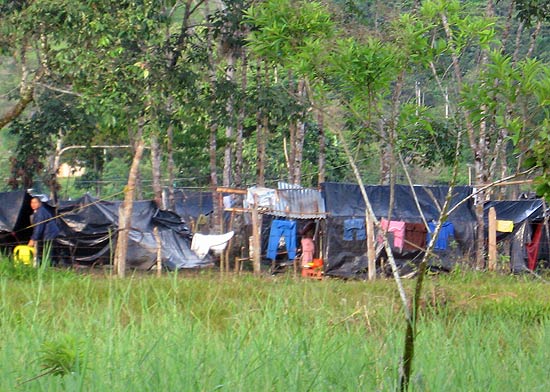 |
The state of Putumayo's legal economy has not been helped appreciably by the alternative development programs that were supposed to be the "soft" or "carrot" side of the fumigation strategy, helping sprayed coca-growers to find new ways to make a living. It is hard to believe that the U.S. and Colombian governments have invested well over $50 million - perhaps as much as $80 million - in Putumayo since 2000. While some projects appear to be having success and buy-in, particularly cooperatives, assistance to indigenous communities, and specialty crops like black pepper and vanilla, the overall reaction I heard was one of frustration.
A major frustration is the road network, a crucial priority if legal crops are to have any hope of making it to market. Lack of roads not only adds to the isolation of communities that remain in the grip of armed groups; it makes it very difficult to get any crops to market - with the exception of coca paste, which allows several hectares' harvest to fit in one bag.
Nearly six years after Plan Colombia began in Putumayo, even the main road between its capital, Mocoa, and its largest city, Puerto Asís - a stretch of less than 100 miles - has not been paved. The road is dirt. (However, paving is currently underway between Puerto Asís and Santana, covering about the first eight miles of the trip to Mocoa.) The segment of road that is paved, between Santana and La Dorada, was paved well before Plan Colombia began, funded by the state oil company in order to service the pipeline that runs along that section of road - and even this has deteriorated since my first visit to Putumayo. All other roads, including those leading to significant towns and villages off the main road, are unpaved and in bone-jarringly bad condition, if they exist at all.
Beyond the road network, I heard several complaints about alternative development projects' design and management. For the most part, these concerns are common to alternative development projects - indeed, rural development efforts - all over the world. People complained that their communities were not consulted in the projects' design, that outside experts unfamiliar with the region told them what crops were most promising, and were often wrong. (The bitter experience of a multimillion-dollar animal-feed plant in Orito, which opened in 2003 and closed in 2005, is an excellent example.) They cited a lack of help with marketing crops once they had been produced: transporting the product on the poor road network and making connections with buyers willing to pay enough for the farmer to clear a profit. Many said that credit was still impossible to come by, and even when it was available, lenders often failed to take into account that many crops take years to produce their first harvest.
Many with whom I spoke were particularly resentful of perceived layers of "middlemen" in the development assistance process. In their view, USAID's contractors, and their Colombian (and rarely Putumayo-based) subcontractors, have accrued the lion's share of development assistance for themselves. Each link in the chain, they assert, has squandered resources on overhead, salaries, consultants, and in some cases petty corruption, leaving only a trickle of investment for the recipient communities. Development practitioners who have worked in Putumayo may find this characterization to be unfair and even provably untrue; nonetheless it is a widespread, nearly unanimous perception. It is the most frequent response to the question, "Why is there so little evidence that many millions of dollars have been spent here on development?"
In defense of the alternative development programs, those I spoke with had few concrete suggestions for alternative crops that could prosper in Putumayo - at least in the absence of decent roads, reliable security, enforceable property rights, access to credit, and much else.
However, I did hear a good deal of interest in developing a market for the many Amazon-basin fruits that Putumayo produces in abundance but are rarely available elsewhere, even elsewhere in Colombia. I recall that ten or fifteen years ago in the northeastern United States, it was very unusual to find mangoes, papayas, or yuca in supermarkets, but now these and other tropical products are commonplace and profitable. If products like chontaduro, lulo, manzana de agua, tomate de árbol, arazá, or uchuva could catch on similarly, Putumayo's farmers would have a potential answer to the alternative development challenge. But right now, outside demand is so low that such fruits command rock-bottom prices. We shared a ride with a farmer who lost a pile of money trying to grow arazá last year, only to find that the prices were laughably low. He said he was thankful that he had kept a little bit of coca to give himself a financial cushion.
While in La Hormiga, I was able to attend a day-long meeting attended by governors of indigenous reservations. Most of the twelve indigenous nations found in Putumayo were represented: Cofán, Inga, Pasto, Nasa, Awá, Embera, Yanacona, and others. They had gathered to discuss Plan Colombia: how it has impacted them, what was to come and what they could do to prepare for it.
It was a great opportunity to listen to communities that had the deepest roots in Putumayo. For the department's indigenous residents, Plan Colombia is only the latest of several close encounters that has left them wary of western "modernity" and the global economy.
A century ago, Putumayo was at the center of a boom in rubber production, during which the region's indigenous people were enslaved and terrorized by the mostly foreign owners of rubber plantations. (Read a harrowing account of this period in anthropologist Michael Taussig's classic 1987 study Shamanism, Colonialism and the Wild Man.) During the late 1960s and early 1970s, the discovery of oil led to another rush of investors and settlers. Today, Putumayo is number two, behind Arauca, among Colombia's oil-producing departments. [Correction as of 8/22: Putumayo's actually 3rd, I forgot Casanare.] As in Arauca, one sees little evidence of the oil wealth, and plans for new drilling continue to be frequent subjects of controversy. Twenty years ago, Putumayo played host to a new export-oriented bonanza that brought in even more settlers from elsewhere in Colombia: the boom in coca production that persists today and continues to make the department one of Colombia's most violent.
For Putumayo's indigenous communities, each of these events has meant an influx of outsiders, theft of land, displacement from territory, and a weakening of the social fabric and cultural traditions. It is unsurprising, then, that they discuss Plan Colombia as inseparable from Colombia's free trade agreement with the United States, big foreign investments (particularly in oil), and fears of massive "megaprojects" that would evict them from their land.
The picture is more complicated than that, not least because several Putumayo indigenous communities have accepted, and benefited from, significant amounts of assistance through USAID-funded Plan Colombia programs. But these communities clearly fear that the "next phase" of Plan Colombia will involve "desterritorialización" - forced displacement from ancestral lands - in favor of foreign investment projects. The installation of the CENAF military base and recent disputes with a Canadian oil company are being viewed as harbingers of what is to come as Plan Colombia proceeds. The U.S. and Colombian governments must endeavor, through adherence to the rule of law and through non-military investments, to convince them that this is not the case.
Flying out of Puerto Asís, one can easily spot plots of coca carved out of Putumayo's swiftly disappearing jungle. One also sees evidence of the near-total isolation in which too many of the department's citizens live. Looking east to the edge of visibility are hundreds of parcels of land gouged from the surrounding forest, most with houses in the middle. No roads or rivers appear to penetrate anywhere near these landholdings. Pushed by a lack of opportunity elsewhere and pulled by the perverse incentives of the coca economy, a small but significant portion of southern Colombia's rural population continues to live far beyond the reach of its government (with the exception of the government's spray planes).
Whether viewed from the air or from the ground, Putumayo offers an abundance of reminders of how much needs to be done to make citizens out of millions of marginalized Colombians. And how little Plan Colombia - with its emphasis on military force and fumigation - has helped to achieve that goal.
No roads or power lines go anywhere near these houses, on one of many very isolated plots of land visible from the air. The light green vegetation in the top picture is probably coca. |
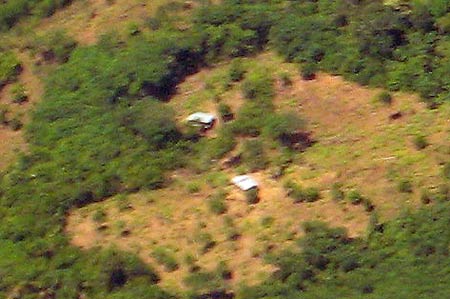 |
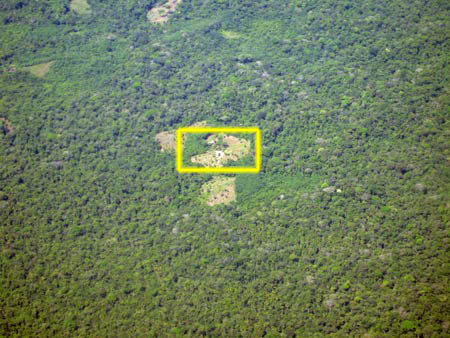 |
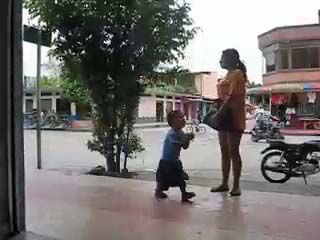 |
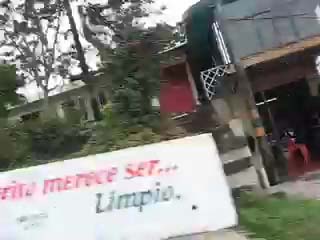 |
Posted by isacson at August 15, 2006 3:54 PM
Comments
Glad to see you're doing fine.
As for Putumayo, your report is interesting as always. But in the end the same trend continues.
Drug policies that are still quite counterproductive have not changed, so it's only a matter of time before the cycle of plantation-fumigation-plantation repeats itself and erases all the gains, unless real, effective changes are implemented.
And until better and greater socio-economic assistance is provided to the community, by understanding and addressing their social and economic needs, Putumayo will continue in its permanently backwards state.
That doesn't mean that simply pouring in more government and USAID resources will resolve all the mentioned ills, but at least things would substantially improve, instead of remaining in an ambigously mixed state will no sign of significant recovery (beyond temporary gains that may or may not last after a few more years).
Posted by: jcg ![[TypeKey Profile Page]](http://www.ciponline.org/colombia/blog/nav-commenters.gif) at August 15, 2006 8:29 PM
at August 15, 2006 8:29 PM
Glad to read Adam's interesting report on Putumayo. From my time in the country, I recall a lack of paved roads being a characteristic even of "developed" parts of Colombia.
I never got anywhere near Putumayo, for which cocaine really does seem to be the only economically viable "agricultural product" right now.
I gather that Adam was quite secure during his travels in Putumayo. I do wonder how safe a gringo living in the area would be.
Posted by: richtiger ![[TypeKey Profile Page]](http://www.ciponline.org/colombia/blog/nav-commenters.gif) at August 17, 2006 1:52 AM
at August 17, 2006 1:52 AM
Hi Adam, and thanks for your report from Putumayo: it is so good to have some first hand testimonies, from time to time!
I will link this entry in my blog.
Kind regards,
Doppiafila
Posted by: Doppiafila ![[TypeKey Profile Page]](http://www.ciponline.org/colombia/blog/nav-commenters.gif) at August 17, 2006 9:22 AM
at August 17, 2006 9:22 AM
Nice post. Just two things I want to comment on the Alternative Development part of the post, since I have had somewhat of an inside perspective these past few years:
1) People working on these AD projects at senior levels (from the contractor's side, not the USAID side) are either a) ignorant of the fiascos that have transpired there and elsewhere(focusing energies on how to make M&E stats look good to USAID); or b) painfully aware of the fiascos and in total agreement with the sentiments of the farmers in Putumayo, as expressed in your post.
The wasteful spending on dubious consultancies, hodge-podge "capacitations," "schools for agriculture excellence," etc., is, from what I have seen, very much a reality. And it never ceases to amaze me how far the contractor is prepared to go to make an utter failure, such as the feed plant mentioned in your post, appear as a glowing success. The execs at the contractor's main offices in Bogota and Washington went on and on about the success of this feed plant when it didn't even exist. The same thing happened with the sawmill in Villa Garzon (also in Putumayo). They published glossy brochures and everything, claiming to provide 61 species of wood. Emperor's new clothes. So I'd say the resentment of Putumayo farmers toward AD and USAID needn't be second-guessed. It is well-founded.
In defense of AD, some projects do have a postive impact, such as in Santander, where a significant decline in coca production was registered in the latest UN satellite survey.
2) Regarding alternative crops, some of the fruit products Adam mentions do show promising export potential, but for that very reason they face a lot of tricky trade politics. For one, I don't think any of the fruits that Adam mentions have been cleared by US APHIS protocol (the only fruits to clear so far are banana, plantain, mango, and gooseberry--this is according to Analdex), and are therefore banned from entry into the US. Most of the other fruits mentioned face huge competition from neighboring countries. Colombia's fruit and vegetable industry is between ten and twenty years behind its neighbors.
A short and sweet (and in hindsight not the best documented) survey of the industry can be found by yours truly here:
Posted by: rainercale ![[TypeKey Profile Page]](http://www.ciponline.org/colombia/blog/nav-commenters.gif) at August 17, 2006 1:45 PM
at August 17, 2006 1:45 PM
Post a comment
Thanks for signing in, . Now you can comment. (sign out)
(If you haven't left a comment here before, you may need to be approved by the site owner before your comment will appear. Until then, it won't appear on the entry. Thanks for waiting.)